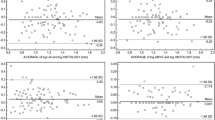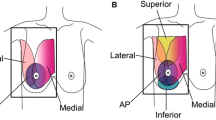Abstract
Purpose
Our aim was to investigate the diagnostic potential of automated breast volume scanning (ABVS) and compare it with manual ultrasound (US) and mammography.
Patients and methods
One hundred and fifty-five patients with a total of 165 breast lesions had mammograms, manual US and an ABVS. Multiplanar reconstructions in coronal, transverse and sagittal views were reconstructed from the automated data set. After biopsy or surgery, all lesions were confirmed histologically. Data were evaluated according to the Breast Imaging Reporting and Data System (BI-RADS) classification. Detection rate, diagnostic accuracy, sensitivity, specificity and positive (PPV) and negative (NPV) predictive value of each method were analysed.
Results
Detection rate, diagnostic accuracy and mammography sensitivity were significantly lower than those of each US method (p<0.05). There were no significant differences between manual US and ABVS. When combining ABVS, US and mammography, diagnostic accuracy, sensitivity and specificity reached 96.4%, 97.1% and 95.2%, respectively. A spiculated and stellate margin in the coronal plane has a high specificity in diagnosing malignant lesions.
Conclusions
ABVS can provide additional information in the differential diagnosis of a lesion. It has significantly higher sensitivity than mammography, but it is similar to manual US and cannot be preferred to a manual US examination.
Riassunto
Obiettivo
Valutare le potenzialità diagnostiche della scansione automatica del volume del seno (ABVS) nei confronti dell’ecografia convenzionale (US) e della mammografia.
Pazienti e metodi
155 pazienti con un totale di 165 lesioni mammarie sono state studiate con mammografia, ecografia convenzionale e scansione automatica del volume mammario (ABVS). Dal volume dei dati acquisiti in modo automatico sono state realizzate ricostruzioni multiplanari nei piani coronale, assiale e sagittale. Tutte le lesioni sono state confermate istologicamente. I dati sono stati valutati secondo la classificazione BI-RADS (Breast Imaging Reporting e Data System). Per ciascuna modalità sono stati analizzati il tasso di rilevamento, l’accuratezza diagnostica, la sensibilità, la specificità, il valore predittivo positivo (VPP) ed il valore predittivo negativo (VPN).
Risultati
Il tasso di rilevamento, l’accuratezza diagnostica e la sensibilità della mammografia erano significativamente inferiori a quelli di ciascun metodo ecografico (p<0,05). Non si sono evidenziate differenze statisticamente significative tra l’ecografia convenzionale e l’ABVS. Quando si combinano l’ABVS, l’ecografia convenzionale e la mammografia, l’accuratezza diagnostica, la sensibilità e la specificità raggiungono il 96,4%, il 97,1% e il 95,2%, rispettivamente. I margini spiculati e stellati nel piano coronale hanno una elevata specificità nella diagnosi di lesioni maligne.
Conclusioni
L’ABVS può fornire ulteriori informazioni nella diagnosi differenziale di una lesione. Esso ha una sensibilità significativamente maggiore della mammografia, ma è simile all’ecografia convenzionale e non può essere preferibile ad un esame ecografico convenzionale.
Similar content being viewed by others
References/Bibliografia
Johnson DD, Pretorius DH, Budorick NE et al (2000) Fetal lip and primary palate: three-dimensional versus twodimensional US. Radiology 217:236–239
Hamper UM, Trapanotto V, DeJong MR et al (1999) Three-dimensional US of the prostate: early experience. Radiology 212:719–723
Downey DB, Fenster A (1995) Vascular imaging with a threedimensional power Doppler system. AJR Am J Roentgenol 165:665–668
Cho N, Moon WK, Cha JH et al (2006) Differentiating benign from malignant solid breast masses: comparison of two-dimensional and three-dimensional US. Radiology 240:26–32
Chang JM, Moon WK, Cho N et al (2011) Breast cancers initially detected by hand-held ultrasound: detection performance of radiologists using automated breast ultrasound data. Acta Radiol 52:8–14
Isobe S, Tozaki M, Yamaguchi M et al (2011) Detectability of breast lesions under the nipple using an automated breast volume scanner: comparison with handheld ultrasonography. Jpn J Radiol 29:361–365
Tozaki M, Isobe S, Yamaguchi M et al (2010) Optimal scanning technique to cover the whole breast using an automated breast volume scanner. Jpn J Radiol 28:325–328
American College of Radiology (1998) Breast imaging reporting and data system (BI-RADS). 3rd edn. American College of Radiology, Reston, VA
American College of Radiology (2003) ACR BI-RADS: ultrasound. In: ACR Breast Imaging Reporting and Data System Breast Imaging Atlas. American College of Radiology, Reston, VA
D’Orsi D, Bassett L, Berg W et al (2003) Breast imaging reporting and data system, BI-RADS: mammography. American College of Radiology, Reston, VA
Landis JR, Koch GG (1977) The measurement of observer agreement for categorical data. Biometrics 33:159–174
Watermann DO, Foldi M, Hanjalicbeck A et al (2005) Three-dimensional ultrasound for the assessment of breast lesions. Ultrasound Obstet Gynecol 25:592–598
Kolb TM, Lichy J, Newhouse JH (1998) Occult cancer in women with dense breasts: detection with screening US-diagnostic yield and tumor characteristics. Radiology 207:191–199
Kotsianos-Hermle D, Hiltawsky KM, Wirth S et al (2009) Analysis of 107 breast lesions with automated 3D ultrasound and comparison with mammography and manual ultrasound. European J Radiol 71:109–115
Rotten D, Levaillant JM, Zerat L (1999) Analysis of normal breast tissue and of solid breast masses using threedimensional ultrasound mammography. Ultrasound Obstet Gynecol 14:114–124
Moon WK, Myung JS, Lee YJ et al (2002) US of ductal carcinoma in situ. RadioGraphics 22:269–280
Stavros AT, Thickman D, Rapp CL et al (1995) Solid breast nodules: use of sonography to distinguish between benign and malignant lesions. Radiology 196:123–134
Nelson TR, Pretorius DH, Lev-Toaff A et al (2001) Feasibility of performing a virtual patient examination using threedimensional ultrasonographic data acquired at remote locations. J Ultrasound Med 20:941–952
Author information
Authors and Affiliations
Corresponding author
Rights and permissions
About this article
Cite this article
Wang, Z.L., Xw, J.H., Li, J.L. et al. Comparison of automated breast volume scanning to hand-held ultrasound and mammography. Radiol med 117, 1287–1293 (2012). https://doi.org/10.1007/s11547-012-0836-4
Received:
Accepted:
Published:
Issue Date:
DOI: https://doi.org/10.1007/s11547-012-0836-4




